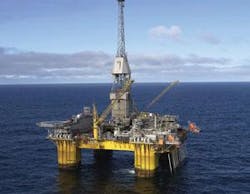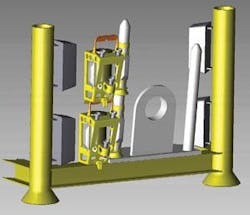Upgrading of communications from subsea wells producing to the Visund platform required a threefold solution that involved retrofitting new communication cards in canisters that attach to existing subsea trees, using existing power lines for communication, and integrating the data topside.
The upgrade improves monitoring of subsea wells so that production from the field’s complex reservoirs can be optimized.
Visund
StatoilHydro operates Visund oil and gas field in Blocks 34/8 and 34/7, 22 km northeast of Gullfaks field in the Tampen area of the Norwegian North Sea.
The field came on stream in 1999 and production is through a semisubmersible processing, drilling, and quarters platform (Fig. 1).
The subsea-completed wells in the field are tied back to the floater with flexible risers. Oil is piped to Gullfaks for storage and export while gas is piped to Europe, with gas exports having started in 2005.
The platform controls 32 subsea wells that produce an average 32,000 b/d and 1.49 billion cu m/day.
Partners in the field are StatoilHydro AS, 53.2%; Petoro AS, 30.00%; Norske ConocoPhillips AS, 9.10%, Total E&P Norge AS, 7.70%.
Interface card
The subsea wells were equipped with four electric pressure-temperature downhole gauges each and integrated into the production control system. StatoilHydro needed to expand the gauges to eight/well, but this required a new generation of downhole interface card.
The card selected was an Intelligent Well Interface Standard (IWIS) card from Roxar ASA that was not compatible with the existing control system. The card also is implemented as an ISO standard, Reference ISO 13628-6.
The subsea industry developed jointly the open interface (mechanical, electrical, and data communication) standard. IWIS provides a transmission control protocol-internet protocol (TCP-IP) link to subsea electronics, and ensures interchangeability of downhole vendor equipment.
Upgrade installation
StatoilHydro faced several obstacles for installing the upgrade. Besides working with a system that did not have built-in expandability, the existing control module did not have room for a new downhole communications card.
Additionally, the upgrade was limited to the existing number of communication wires in the umbilical and on the seafloor that were already at capacity.
To install the additional downhole gauges with minimal effects on the existing control system, StatoilHydro used a retrofit solution from SICOM, now a Weatherford International company.
The SICOM solution required installation of a new subsea canister with a remotely operated vehicle (ROV). The modem within the new canister communicates on the existing umbilical cables and integrates the new data seamlessly into the management system on the rig.
SICOM’s i100 power-line modem provides TCP/IP and Ethernet communication with a bandwidth of up to 400 kbits/sec. The former system at Visund and most other North Sea installations run at speeds up to 1.2 kbits/sec.
The upgrade used the existing communication wires, but rather than as single channel lines, the wires form a part of a multiplexed system that handles information for several wells. The multiplexed data are similar to a digital subscriber line (DSL) on a home phone line that allows transmissions without interrupting phone calls.
The process sends data packets through the power lines in an unused frequency band. At the other end of the line, the i100 modem captures and decodes the packets, as well as facilitating finding the optimum frequencies for each communication channel based on interference from power and other communication impulses.
This system permits as many as eight wells to communicate simultaneously on one line.
Because the existing control modules did not have additional capacity to accept an IWIS communication card, the upgrade required fabrication and installation of a new canister that fit on the existing subsea tree (Fig. 2).
The ROV-installed canister contains the IWIS card and the modem that controls communication on the power lines. The new system bypasses the former system with new jumpers that connect the new canister to the new downhole gauges.
The canisters were installed easily on the guideposts of the infrequently used remote tie-in system (RTS) on the subsea tree. The canisters can be removed for servicing if needed.
The RTS guideposts are used for tie in of flexible risers between the subsea tree and floating production unit.
The modems connect to the power lines and use the minimal power needed for communications. They pass the electricity onto the control system with virtually no loss or interruption to the control system. The multiplex communication on the power lines provides the communication channels for the required number of gauges in the wells. The modems can handle communication protocols for the major subsea communication systems, assuring an open system in the future if additional upgrades are needed.
Topsides server
A topside server now handles communication with the subsea modules and integrates the data received into the existing software systems on the rig. These include the safety automation system (SAS) based on Teleperm programmable logic controllers (PLCs) and the information management system consisting of an Aspentech IP21 database for storage of all historic data.
The software includes an open OPC DA interface for data exchange with external systems including all major databases.
The information management system gives the user the opportunity to analyze reservoir data in detail and optimize production. The additional four pressure-temperature gauges in the well provide the data resolution needed for more detailed analysis.
Benefits
The project organization made it possible to install an upgrade in an already existing design by implementing state of the art communication and control systems. The work also demonstrated the potential for retrofitting communications on existing assets.
The new system adds redundancy by allowing the installation of eight gauges/well instead of the original four gauges/well. This means that the operator can now monitor performance in wells with more complex reservoir structures.
Communications with wells are now faster and more reliable. Rather than one well/communication channel, the new system provides up to eight wells/communication channel. The system increased communication speed to 390 kbits/sec from 1.2 kbits/sec.
The operator also now can access the information remotely, through the internet. Information monitored and serviced remotely means that service is prompt and cost effective.
With the success of this project, StatoilHydro may expand the monitoring capabilities of downhole gauges to other wells in this field and in other subsea fields.
Acknowledgment
The project required the cooperation and efforts of Per-Ole Ingebrigtsen, StatoilHydro controls and operations, Olav Westrheim, StatoilHydro well and drilling, and Frode Haugen, StatoilHydro topside instrumentation.
The author
Lars E. Mathisen is the technical sales manager for SICOM AS a company within the production optimization business unit of Weatherford International Inc. Mathisen has 20 years of experience in the high-technology industry. Before his position with SICOM, he was vice-president of automation in Kongsberg Maritime and product manager in Autronica. Prior to that, he was research manager at the MARINTEK research institute. Mathisen holds an MS in naval architecture from the Norwegian Technical University and a business degree from Norwegian School of Management. He is a member of IMO, IEC, and IWIS committees.





